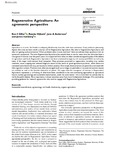| dc.contributor.author | Giller, Ken E. | |
| dc.contributor.author | Hijbeek, Renske | |
| dc.contributor.author | Andersson, Jens A | |
| dc.contributor.author | Sumberg, James | |
| dc.date.accessioned | 2021-03-11T15:36:46Z | |
| dc.date.available | 2021-03-11T15:36:46Z | |
| dc.date.issued | 2021-03-02 | |
| dc.identifier.citation | Giller, K.E.; Hijbeek, R.; Andersson, J.A.; and Sumberg, J. (2021) 'Regenerative Agriculture: An Agronomic Perspective', Outlook on Agriculture: 1-13, doi:10.1177/0030727021998063 | en |
| dc.identifier.uri | https://opendocs.ids.ac.uk/opendocs/handle/20.500.12413/16464 | |
| dc.description.abstract | Agriculture is in crisis. Soil health is collapsing. Biodiversity faces the sixth mass extinction. Crop yields are plateauing. Against this crisis narrative swells a clarion call for Regenerative Agriculture. But what is Regenerative Agriculture, and why is it gaining such prominence? Which problems does it solve, and how? Here we address these questions from an agronomic perspective. The term Regenerative Agriculture has actually been in use for some time, but there has been a resurgence of interest over the past 5 years. It is supported from what are often considered opposite poles of the debate on agriculture and food. Regenerative Agriculture has been promoted strongly by civil society and NGOs as well as by many of the major multi-national food companies. Many practices promoted as regenerative, including crop residue retention, cover cropping and reduced tillage are central to the canon of ‘good agricultural practices’, while others are contested and at best niche (e.g. permaculture, holistic grazing). Worryingly, these practices are generally promoted with little regard to context. Practices most often encouraged (such as no tillage, no pesticides or no external nutrient inputs) are unlikely to lead to the benefits claimed in all places. We argue that the resurgence of interest in Regenerative Agriculture represents a re-framing of what have been considered to be two contrasting approaches to agricultural futures, namely agroecology and sustainable intensification, under the same banner. This is more likely to confuse than to clarify the public debate. More importantly, it draws attention away from more fundamental challenges. We conclude by providing guidance for research agronomists who want to engage with Regenerative Agriculture. | en |
| dc.language.iso | en | en |
| dc.publisher | Sage Journals | en |
| dc.relation.ispartofseries | Outlook on Agriculture; | |
| dc.rights.uri | http://creativecommons.org/licenses/by-nc/4.0/ | en |
| dc.subject | Agriculture | en |
| dc.title | Regenerative Agriculture: An Agronomic Perspective | en |
| dc.type | Article | en |
| dc.rights.holder | © The Author(s) 2021 | en |
| dc.identifier.externaluri | https://journals.sagepub.com/doi/10.1177/0030727021998063 | en |
| dc.identifier.team | Rural Futures | en |
| dc.identifier.doi | 10.1177/0030727021998063 | |
| rioxxterms.funder | Default funder | en |
| rioxxterms.identifier.project | Default project | en |
| rioxxterms.version | VoR | en |
| rioxxterms.versionofrecord | 10.1177/0030727021998063 | en |
| rioxxterms.funder.project | 9ce4e4dc-26e9-4d78-96e9-15e4dcac0642 | en |


